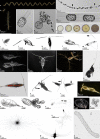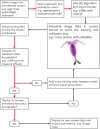Machine learning techniques to characterize functional traits of plankton from image data
- PMID: 36247386
- PMCID: PMC9543351
- DOI: 10.1002/lno.12101
Machine learning techniques to characterize functional traits of plankton from image data
Abstract
Plankton imaging systems supported by automated classification and analysis have improved ecologists' ability to observe aquatic ecosystems. Today, we are on the cusp of reliably tracking plankton populations with a suite of lab-based and in situ tools, collecting imaging data at unprecedentedly fine spatial and temporal scales. But these data have potential well beyond examining the abundances of different taxa; the individual images themselves contain a wealth of information on functional traits. Here, we outline traits that could be measured from image data, suggest machine learning and computer vision approaches to extract functional trait information from the images, and discuss promising avenues for novel studies. The approaches we discuss are data agnostic and are broadly applicable to imagery of other aquatic or terrestrial organisms.
© 2022 The Authors. Limnology and Oceanography published by Wiley Periodicals LLC on behalf of Association for the Sciences of Limnology and Oceanography.
Conflict of interest statement
None declared.
Figures





References
-
- Acuña, J. L. , López‐Urrutia Á., and Colin S.. 2011. Faking giants: the evolution of high prey clearance rates in jellyfishes. Science 333: 1627–1629. - PubMed
-
- Aksnes, D. L. , and Giske J.. 1990. Habitat profitability in pelagic environments. Mar. Ecol. Prog. Ser. 64: 209–215.
-
- Alldredge, A. L. 1981. The impact of appendicularian grazing on natural food concentrations in situ 1. Limnol. Oceanogr. 26: 247–257.
-
- Alldredge, A. L. , and Silver M. W.. 1988. Characteristics, dynamics and significance of marine snow. Prog. Oceanogr. 20: 41–82.
-
- Allken, V. , Handegard N. O., Rosen S., Schreyeck T., Mahiout T., and Malde K.. 2019. Fish species identification using a convolutional neural network trained on synthetic data. ICES J. Mar. Sci. 76: 342–349.
Publication types
LinkOut - more resources
Full Text Sources
Miscellaneous
